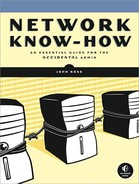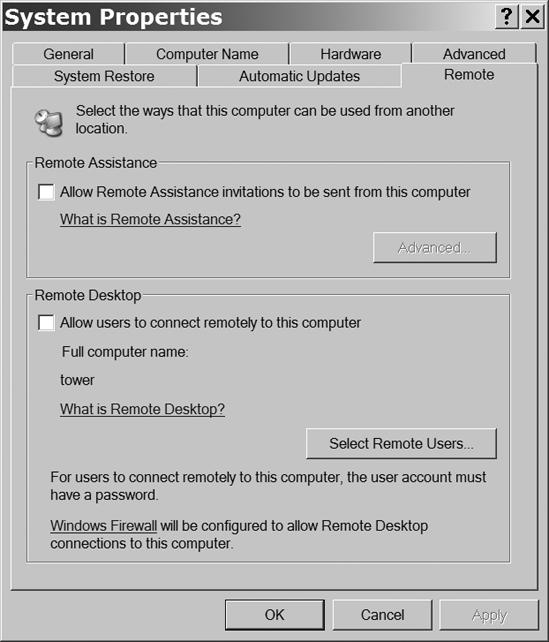Most people use a network for a limited number of purposes; they share files and messages, connect to the Internet, and maybe play multiplayer games or listen to music and watch videos from a server. But once you have your home or small business network up and running, you can use the network to accomplish some things you might not have expected.
This chapter describes a handful of other useful network applications. None of these is reason enough to install a network, but if you have come this far, you're already using the network for other purposes. Consider the network programs and services in this chapter as lagniappe, a little extra that might enhance your networking experience.
Remote Desktop programs allow another user, with your permission, to take control of your computer through a network. When a remote control program is active, a network manager or service technician can distribute and install new or updated software, provide help and remote assistance, and view information on other computers. Remote Desktop programs are a standard feature in Windows XP, Windows Vista, and Macintosh.
Several open source remote desktop programs for Linux and Unix are also available, including Virtual Network Computing (VNC), FreeNX, 2X Terminal Server, and X Display Manager Control Protocol. You can find links to downloads for all of these programs at http://blog.lxpages.com/2007/03/13/remote-desktop-for-linux/. For Mac-to-Windows remote access, try Microsoft's Remote Desktop Connection Client for Mac (http://www.microsoft.com/mac/products/remote-desktop/). For Windows-to-Mac, use a Windows-based VNC client such as RealVNC or TightVNC. You will find more information about VNC later in this section.
Windows Remote Desktop transfers control of a client computer to a host. The host mirrors the screen display from the client, and the host's mouse and keyboard control the programs running on the client. When Remote Desktop is active, the client computer displays a blank screen and doesn't respond to keyboard or mouse input until the host releases control.
Remote Desktop makes the person running the host computer a sort of superuser who can take control of a client computer, so several controls are built into the system that limit this kind of access: First, the user of the client must set the computer to accept Remote Desktop access, and second, the person running Remote Desktop on the host computer must have an account (usually with a password) on the client computer. In other words, if you turn off Remote Desktop on your computer, other people can't use it without your permission.
In Windows XP, the remote access tool is called Remote Access; in Windows Vista, it's known as Remote Desktop. Computers running Windows Vista Starter, Windows Vista Home Basic, Windows Vista Home Basic N, or Windows Vista Home Premium won't accept incoming access, but you can use Remote Desktop to take control of another computer running some other version of Vista. Windows XP Home Edition won't accept access from any Windows Vista machine.
To configure a Windows XP computer to accept Remote Desktop access, follow these steps:
Right-click My Computer. A pop-up menu will appear.
Select Properties from the menu. The System Properties window will open.
Click the Remote tab. The dialog shown in Figure 16-1 will appear.
To use this computer to control other computers remotely on your network, check the Allow Remote Assistance invitations . . . option in the Remote Assistance area.
To permit another computer on your network to take control of this computer, check the Allow users to connect remotely . . . option.
When Allow users to connect remotely to this computer is turned on, anybody who is logged on to another machine on the same network with the same username as an Administrator account on this computer—and who uses a password to log into this computer—can request remote access. To allow a non-Administrator to use Remote Access, click the Select Remote Users button, click the Add button in the Remote Desktop Users window, and then type the account name for the person who you want to allow to use Remote Access.
Click the OK buttons in each of the open windows to save your data and close the windows.
To configure Windows Vista for Remote Assistance, follow these steps:
Right-click My Computer. The System window will appear.
Click Remote settings in the Tasks list on the right side of the window. The System Properties window will appear with the Remote tab visible, as shown in Figure 16-2.
Check the Allow Remote Assistance connections to this computer option. Activating this option will allow both inbound and outbound remote access.
Click OK to save your settings and close the Properties window.
To take control of another computer using Remote Desktop in Windows XP or Remote Assistance in Windows Vista, follow these steps:
Select Start ▸ All Programs ▸ Accessories ▸ Remote Desktop Connection. A dialog similar to the one shown in Figure 16-3 will appear.
Type the name of the computer you want to control, and click Connect. Your screen will go black, except for a control tab near the top of the screen and a Log On box.
Type a valid account name and password for the target computer in the Log On box and click OK. The screen on the distant computer will go dark, and you will see an image of the distant computer's desktop on your screen.
You can now control the distant system with your own computer's keyboard and mouse. You can open files, run tests, and load programs though the network. However, a user looking at the distant computer's screen will see nothing but a dark screen.
When a new Remote Desktop connection opens, it fills the client computer's screen, but you can reduce the size of the Remote Desktop window and see your own computer's desktop and Start menu by clicking the sizing icon on the Remote Desktop tab at the top of the screen. This will allow you to copy text, data, or files between the two computers.
To return control to the local user, click the X on the control tab near the top of the screen.
Note
If you try to use an account without a password to take over a Remote Desktop connection, you will get this error message: Unable to log you on because of an account restriction. If you see this message, go to Control Panel▸ User Accounts on the target computer, select Change an account to assign a password to your account, and then try connecting again.
Virtual Network Computing (VNC) is a system that allows one computer (the client) to gain remote access to a second computer (the server) and to use the first computer's mouse and keyboard to control the second computer. In general, VNC is not as fast as the Windows and Macintosh remote desktop programs, but it's more flexible. Unlike the Microsoft tools described in the previous section, VNC is not limited to any operating system; you can use any VNC client (or viewer) to control any VNC server—even if the two computers use different operating systems.
Several VNC-based programs are available that offer clients and servers for more than one operating system, including RealVNC (http://www.realvnc.com/), UltraVNC (http://www.uvnc.com/), and TightVNC (http://www.tightvnc.com/). Several others are limited to Linux and Unix operating systems. For descriptions and links to additional versions, go to http://www.linux.com/feature/43165.



